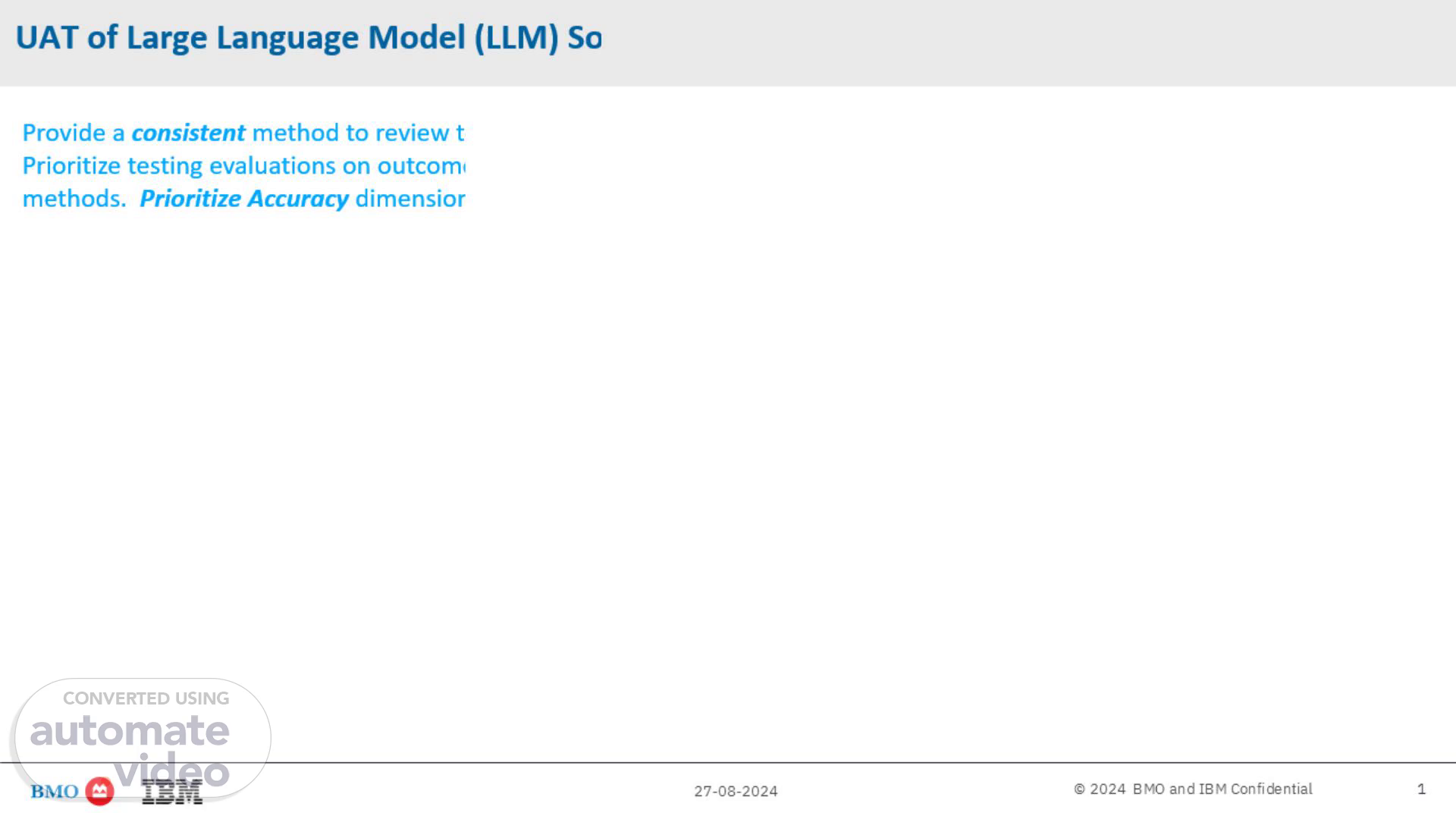
UAT of Large Language Model (LLM) Solutions
Scene 1 (0s)
UAT of Large Language Model (LLM) Solutions. [image] Accuracy calibrate compass measure.
Scene 2 (50s)
AI-LLM Model(s) Validation Checklist. SL No Acitivity# Description 1 Understand the System Review the overall architecture and components of the system 2 Model Used / Models Used Identify the machine learning model(s) used in the system 3 Starting Point: Large Model Verify that the model is a large, well-established model 4 What it is Good At Identify the specific tasks or use cases that the model is designed for 5 Core Skills / Capability Determine the primary skills or capabilities of the model (e.g. classification, regression, etc.) 6 Training Data Review the dataset used to train the model 7 Business Concerns Identify specific business concerns related to the model (e.g. accuracy, bias, etc.) 8 Boundaries and Edge Cases Determine the boundaries of the model’s capabilities and identify edge cases that may require special handling 9 Test the Data Verify that the model has been tested on a representative dataset 10 Corpus Review the corpus of data used to train the model 11 Content Review the content of the data used to train the model 12 Clean Data Verify that the data used to train the model is clean and free of errors 13 PI / PSI Tests Review results of privacy and security tests (PI and PSI) 14 SAFE Measures / AI Guardrails Verify that the model has been designed with safety measures and AI guardrails in place 15 Validate for HHH (Helpful, Honest, and Harmless) Validate that the model is helpful, honest, and harmless in its intended use 16 Weights / Data Biases Review the weights and data biases used in the model to ensure fairness and accuracy.
Scene 3 (1m 57s)
Extending focus to validate LLMS. Approach and validation required.
Scene 4 (2m 38s)
Testing Types with LLM. Testing Type Description Functional Testing Correctness of Output Validate that the model’s outputs are correct and relevant for given inputs. This can be done by: - Comparative Analysis: Compare the model’s outputs with expected outputs or benchmarks. - Ground Truth Testing: For tasks like summarization or translation, compare model outputs with reference outputs. Task Specific Performance : Ensure the model performs well on specific tasks it’s designed for, such as text completion, question answering, or dialogue generation. Performance Response Time: Measure the time it takes for the model to generate outputs. This is important for user experience, especially in real-time applications. Load Testing : Simulate high volumes of requests to test how the model handles stress and whether it maintains performance under load. Scalability Testing : Test how well the model scales with increased load and whether it maintains its performance when scaled horizontally or vertically. Quality and Coherence Fluency & Coherence : Evaluate the grammatical correctness, fluency, and coherence of the generated text. This can be assessed using automated tools or human evaluators. Relevance & Order of relevance: Ensure the model’s responses are relevant and contextually appropriate for the given inputs. Creativity and Novelty: For creative tasks, such as storytelling or brainstorming, assess the originality and creativity of the outputs. Robustness and Error Handling Adversarial Testing: Test how the model handles adversarial inputs designed to provoke erroneous or nonsensical responses. Edge Cases: Examine how the model deals with rare or extreme inputs that might not be common in typical training data Error Analysis: Analyse the types of errors the model produces and identify patterns or common failure modes..
Scene 5 (3m 43s)
Testing Types with LLM. Bais & Fairness Bias Detection: Evaluate the model for biases related to gender, race, ethnicity, or other factors. Use tools and techniques to detect and measure such biases. Fairness Analysis: Ensure the model’s outputs do not perpetuate stereotypes or unfairly discriminate against any group. Safety and compliance Ensure compliance with relevant regulations and guidelines Data privacy laws such as GDPR and CCPA should be considered Test for the generation of harmful, offensive, or toxic content Use automated tools and manual reviews to identify and mitigate these issues Usability Evaluate the ease of integration with existing systems or workflows Assess API usability and documentation quality Collect user feedback on the model's outputs and interaction quality Automated Develop automated tests for functional, performance, and quality checks Utilize test frameworks for input-output validations and regression testing Integrate automated tests into CI/CD pipelines for ongoing quality assurance Human Evaluation Engage domain experts to review the model's outputs for quality, relevance, and accuracy Seek expert opinions for complex or nuanced tasks Gather diverse feedback on model outputs through crowdsourcing platforms Metrics and reporting Supplement quantitative metrics with qualitative analysis Document test results, identified issues, and areas for improvement Utilize quantitative metrics like BLEU, ROUGE, or perplexity to evaluate model performance Visualize performance trends and metrics through dashboards and reports Real World Testing Deploy the model in a controlled environment or with a subset of users for real-world performance observation Gather feedback through pilot deployments Conduct A/B tests to compare performance against baselines or alternative models.